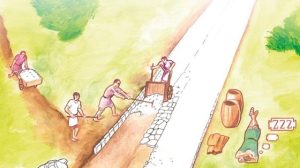30 March 2022 - 30 December 2022
“All roads lead to Rome” – goes the, in fact medieval, proverb we can also hear and read today. Indeed, at the heart of the ancient Roman Empire’s road system was the capital, Rome, the starting point of the main roads. At the same time, however, all provinces were covered by a dense network of upper and lower tier roads, which branched off from the aforementioned main routes. The soundly-built and well-maintained roads were the key to army movements, the smooth operation of the imperial post (i.e. efficient administration from Britain to Syria), and also the unhindered flow of commerce, and they even enabled ancient tourism. In addition to the roads traversing the interior of the Empire, highly significant were the roads running along the Empire’s frontiers. These connected the legionary and auxiliary forts, watchtowers and towns on the border, collectively forming with them the complex frontier defence system, the limes. We can find not just within the Empire, but also beyond its borders, routes used by Roman troops and traders, which, too, primarily played a role in the defence of the frontier (e.g. connecting the so-called bridgehead forts on the other side of the Danube), and also in the transportation of valuable commodities from beyond the borders. Highly important were for example the routes with a typically west-east orientation running towards the interior of the Alföld (Great Hungarian Plain), along which slaves and live animals were brought to Lower Pannonia, or, for instance, the Silk Road, through which came, along the eponymous silk, valuable and rare spices – among others – to the Empire.
In addition to roads on land, water routes too had, of course, an immense role in the Roman Empire. Merchant ships brought across the Mediterranean Sea from spring to late autumn grain from Egypt, garum (fish sauce) from North Africa, and oil and wine from Hispania and the Aegean to the tables of the wealthy aristocracy of Rome and the provinces. Meanwhile river routes (Rhine, Danube) primarily contributed to the supply of the army stationed along the limes (transportation of wine, grain, and items for everyday use, e.g. pots).
Our exhibition guides visitors along these land and water routes, looking at where they ran, how they were established, as well as who travelled on them and by what means. We will also explore what is left of the famous roads of ancient Rome.
Curators: Orsolya Láng, Katalin Lengyelné Kurucz, Nikoletta Varga, Barbara Hajdu, Paula Zsidi



